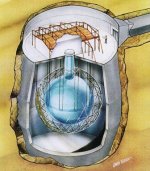
|
Scientists track down mysteries of solar neutrinos, cosmic rays
Posted: Thu, Apr 25, 2002, 6:30 AM ET (1030 GMT)  Scientists have found new evidence that explains the mystery of "missing" solar neutrinos as well as the origins of the most powerful cosmic rays. Scientists announced at a recent meeting of the American Physical Society and American Astronomical Society in Albuquerque that they believe that the Sun emits as many neutrinos as predicted by existing models, but that some of those neutrinos change from one type to another while passing through matter. These findings, which confirm preliminary results announced last year, appear to solve the "solar neutrino problem" first identified in the 1960s when neutrino detectors failed to find as many neutrinos as predicted by theory. At the same conference, another team of astronomers announced that they have linked the most energetic types of cosmic rays with "retired" quasars: supermassive black holes in the centers of galaxies that no longer emit huge amounts of x-rays. These black holes accelerate subatomic particles that each have the same amount of energy as a major league fastball.
Scientists have found new evidence that explains the mystery of "missing" solar neutrinos as well as the origins of the most powerful cosmic rays. Scientists announced at a recent meeting of the American Physical Society and American Astronomical Society in Albuquerque that they believe that the Sun emits as many neutrinos as predicted by existing models, but that some of those neutrinos change from one type to another while passing through matter. These findings, which confirm preliminary results announced last year, appear to solve the "solar neutrino problem" first identified in the 1960s when neutrino detectors failed to find as many neutrinos as predicted by theory. At the same conference, another team of astronomers announced that they have linked the most energetic types of cosmic rays with "retired" quasars: supermassive black holes in the centers of galaxies that no longer emit huge amounts of x-rays. These black holes accelerate subatomic particles that each have the same amount of energy as a major league fastball.
Related Links:
|
|
|
about spacetoday.net · info@spacetoday.net · mailing list |